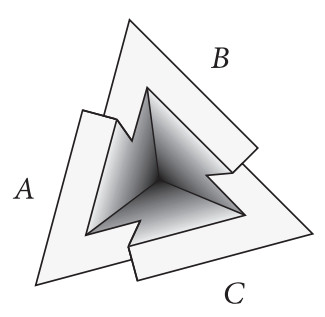
This building, at 1643 Plaza de los Carros in Madrid, is half illusion — the façade on the left, including the windows, ironwork, awnings, even the residents, is all a trompe-l’œil mural by artist Alberto Pirrongelli.

This building, at 1643 Plaza de los Carros in Madrid, is half illusion — the façade on the left, including the windows, ironwork, awnings, even the residents, is all a trompe-l’œil mural by artist Alberto Pirrongelli.
Back in 2007 I noted the report of a curious wager in Berkshire in 1811: Sir John Throckmorton of Newbury bet a thousand guineas that he could have a coat made between sunrise and sunset of a single summer’s day, from the shearing of the sheep to the finished coat’s delivery by the tailor.
This appears to be true — in 1899 the Strand published a retrospective of the feat, including the first photo of the finished coat and the remarks of 93-year-old Charles Coxeter, the sole surviving witness and the younger brother of John Coxeter, the cloth manufacturer who had superintended most of the work. The sheep had been sheared at 5 a.m., and by 6:20 p.m. Throckmorton was able to don the finish coat before a crowd of 5,000 people, an hour and three-quarters before the deadline.
Coxeter was a curiously ambitious man: After the Battle of Waterloo he sponsored the preparation of a plum pudding 20 feet long, “which was cooked under the supervision of twelve ladies.” The “monster pudding” was carried to his house on a timber wagon drawn by two oxen and declared by all who partook “as nice as mother makes ’em.”

For his article “A Universal Money Pump for the Myopic, Naive, and Minimally Sophisticated,” in the April 2025 issue of Mind, philosopher Johan Gustafsson devised this minimal paradoxical stairway to illustrate a cyclic ranking: A appears higher than B, B appears higher than C, and C appears higher than A.
Two other perplexities, while we’re at it — by Mike Tolleb:

And by Wikimedia user Mabit1:

(Thanks, Johan.)
“I like large parties. They’re so intimate. At small parties there isn’t any privacy.” — Jordan Baker in The Great Gatsby
“At any gathering I always feel as though I am the youngest person in the room.” — W.H. Auden
“The difference between what is commonly called ordinary company and good company, is only hearing the same things said in a little room or in a large saloon, at small tables or at great tables, before two candles or twenty sconces.” — Pope, Thoughts on Various Subjects, 1727

In 1980, Japanese astrophysicist Kōryō Miura worked out a pattern of parallelograms that permit a map to be folded much more compactly than conventional right-angle creases. So efficient is the pattern that a map can be opened or refolded with a single motion by pulling on opposite ends, rather like an accordion. Today it’s used to fold surgical devices, furniture, and solar panel arrays on spacecraft.
By Louis Phillips, a poem that reads the same upside down:
MOM SWIMS WOW
In spite of her sniffle
Isabel’s chiffle.
Some girls with a sniffle
Would be weepy and tiffle;
They would look awful,
Like a rained-on waffle,
But Isabel’s chiffle
In spite of her sniffle.
Her nose is more red
With a cold in her head,
But then, to be sure,
Her eyes are bluer.
Some girls with a snuffle,
Their tempers are uffle.
But when Isabel’s snivelly
She’s snivelly civilly,
And when she’s snuffly
She’s perfectly luffly.
— Ogden Nash
During lunch one day at Los Alamos, Richard Feynman told his colleagues, “I can work out in sixty seconds the answer to any problem that anybody can state in ten seconds, to 10 percent!”
He had completed several challenges when mathematician Paul Olum walked past.
‘Hey, Paul!’ they call out. ‘Feynman’s terrific! We give him a problem that can be stated in ten seconds, and in a minute he gets the answer to 10 percent. Why don’t you give him one?’
Without hardly stopping, he says, ‘The tangent of 10 to the 100th.’
“I was sunk: you have to divide by pi to 100 decimal places! It was hopeless. … He was a very smart fellow.”
(From Surely You’re Joking, Mr. Feynman!, 1985.)
In this 1515 painting, The Adoration of the Christ Child, the angel immediately to Mary’s left appears to bear the characteristic facial features of Down syndrome (click to enlarge). This would make the painting one of the earliest representations of the syndrome in Western art.
Unfortunately, little is known about it. The Metropolitan Museum of Art, which owns it, has identified the painter only as a “follower of Jan Joest of Kalkar.” Researchers Andrew Levitas and Cheryl Reid have suggested that the painting may indicate that individuals with Down syndrome were not regarded as disabled in medieval society. But so little is known about the work or its creator that it’s hard to establish a reliable conclusion.
“After all the speculations, we are left with a haunting late-medieval image of a person with apparent Down syndrome with all the accouterments of divinity. It is impossible to know whether any disability had been recognized or whether it simply was not relevant in that time and place.”
(Andrew S. Levitas and Cheryl S. Reid, “An Angel With Down Syndrome in a Sixteenth Century Flemish Nativity Painting,” American Journal of Medical Genetics Part A 116:4 [2003], 399-405.) (Thanks, Serge.)
A puzzle from Chris Maslanka’s The Pyrgic Puzzler, 1987:
A bathtub will fill in 3 minutes if the plug is in and the cold tap only is turned on full. It will fill in 4 minutes if the plug is in and the hot tap only is turned on full. With the plug out and both taps off, a full tub will drain in 2 minutes. How long will it take to fill the empty tub if the plug is out and both taps are turned on full?